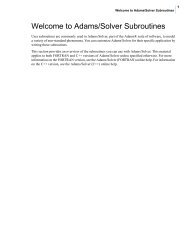You also want an ePaper? Increase the reach of your titles
YUMPU automatically turns print PDFs into web optimized ePapers that Google loves.
<strong>ICAM</strong> <strong>Virtual</strong> <strong>Machine</strong> ® Version 19.0 <strong>Virtual</strong> <strong>Machine</strong> Reference, Menu Bar<br />
Simulation»Options (Ctrl Alt O)<br />
spective vs. orthogonal). When this check box is cleared, the camera jumps directly to<br />
each new viewpoint.<br />
� The Default to Camera mode check box sets the default<br />
functionality of the left-mouse button. When set, the default<br />
is “Camera” mode; meaning that the left-mouse button<br />
controls the orientation of the camera, and the Ctrl button must be held down to select<br />
objects. When this check box is clear, the default is “Selection” mode; meaning that the<br />
left-mouse button is used to select objects, and the Ctrl button must be held down to orient<br />
the camera. The Camera and Selection mode defaults can also be set using the camera<br />
and pointer buttons shown circled above on the VM Mode toolbar.<br />
� The Enable CL CAMERA check box when set allows the simulation window viewpoint<br />
to be changed under post processor or part program control, using the CAMERA post<br />
processor command. Clear this check box to ignore CAMERA post processor command<br />
settings.<br />
� The Show collision interference check box when set will dynamically show, as a yellow<br />
line, the intersection between colliding objects. Computing the intersection takes considerably<br />
more CPU than simply detecting if a collision has occurred. You can disable the<br />
viewing of collision interference if you encounter unacceptable performance with colliding<br />
objects on complex scenes.<br />
� The Limit Timeline memory check box and associated input field can be used to avoid<br />
out-of-memory conditions on very large programs. If set, the Timeline window will only<br />
use the specified amount of memory to track the events of the model. Once the limit has<br />
been reached, events earlier in the program will no longer be accessible via the Timeline<br />
window.<br />
� The Gouge tolerance setting specifies an acceptable collision tolerance between the cutting<br />
portion of the tool and the part model. Some undercutting is to be expected, which is<br />
normally a function of the manufacturing tolerance used by the CAM system. When the<br />
Material Removal Simulation (MRS) license option is enabled, the gouge tolerance also<br />
defines the cutting tolerance to use when computing the in-process stock. The actual cutting<br />
tolerance used is a function of the gouge tolerance and tool usage (see tool usage description<br />
on page 82)<br />
� The Collision tolerance setting specifies the accuracy in space of the beginning and end<br />
of a collision event between two objects.<br />
� The Faceting tolerance setting specifies the accuracy of mesh objects generated at<br />
runtime from swept profiles. A tighter tolerance produces more accurate results, but at<br />
the cost of increased memory and CPU. One of the key uses of the faceting tolerance is in<br />
the generation of 3D tooling given either a 2D profile or tool definition parameters (i.e.,<br />
diameter, corner radius, length…).<br />
120 <strong>ICAM</strong> Technologies Corporation – Proprietary















